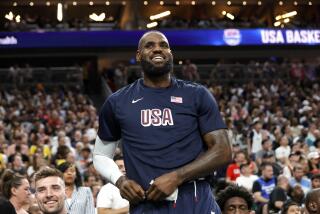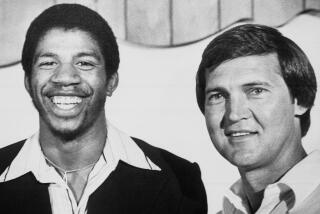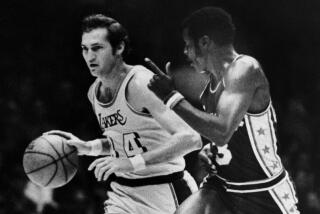The Tao of Pau
- Share via
BARCELONA, Spain -- Not that we tread in some sort of fable with Pau Gasol’s life story here, but you really should see the hospital where he joined the world on July 6, 1980, just seven weeks after Magic scored 42 at Philadelphia.
Really now, how many hospitals do you know that look like some cross between Shangri-La and the Hotel del Coronado? How many caress the eyes with murals, mosaics, sculptures or the two soaring palms that tower out front at L’Hospital Sant Pau? How many boast one of the most enchanting views on Earth, back down the avenue to the Sagrada Familia, plus a striking courtyard with tourists filing through snapping photographs?
At how many hospitals do people seem to want to, you know, hang out?
“One of my friends was working there” as an obstetrician, said Gasol’s mother, Marisa, herself a doctor of internal medicine, “and I went to him to take my boy. It’s such a beautiful hospital.”
And not that we’re witnessing some charmed tale here -- a ton of toil fed Gasol’s ascent -- but here’s an afternoon metro, clean and energetic. It sails underground out of Barcelona through this optimistic, in-the-moment country (and when did you last see one of those?), and when it bobs out of the ground nine stops from town, it’s all Catalonian sunshine and distant brown mountains and Sant Boi de Llobregat.
That’s the fairy-tale name of the industrial, 80,000-strong suburb where Gasol’s hands began their two-decade love affair with the basketball. That’s where the fenced-in schoolyard of his childhood sits in a back corner of town, beyond the streets with local shops and the bus stops with “Juno” ads.
And that’s close to a gloriously eccentric basketball objet d’art that strides the middle of an intersection and bears Gasol’s name, and just across the street from the colossal Complex Esportiu Municipal Pau Gasol, dedicated by the city council after the giant’s rookie season.
How idyllic, this childhood? As the eldest of three sons of a doctor (Marisa) and a nursing administrator (Agusti), Gasol would walk to Escola Llor, the envied private school with the metal front gate and the muscular sports program. It’d take five minutes, if that. He might pass through a becoming neighborhood with orange trees and palms and hedges, tight streets and nonconformist houses, where a single straggler can rouse half a dozen dog barks.
He would see life from 6 feet 4 by 15, sprout again toward his avowed 7 feet at 18 and 19 and, with the junior national team, help portend Spain’s rise to global multi-sport bigwig with eminence in soccer, tennis, golf, Olympics, motorsports, basketball and what-all. He would learn piano and tackle Tchaikovsky’s “Dance of the Swans” and go to medical school for a year before basketball shooed all else, and you mean to say that now the whole Catalonian daydream shifts to . . . Los Angeles, global capital of pixie dust?
It’s another dollop of sensation for a stylish, onrushing country, and even in a sleepy suburb, it has kept a few people up at night. Tuesday night, no, Wednesday morning, Irish tavern, only place in Sant Boi showing Lakers-Nets from New Jersey, your basic 1:30 a.m. tipoff, four middle-aged men who knew Gasol back then, only customers in the pub. Even though his 6:30 wake-up beckoned, Ricard Farres, the director of the immense sports program at Escola Llor, joined three friends to scrutinize a game Farres found almost surreal because Kobe Bryant seemed to defer to his former pupil Gasol.
Then halftime came, and the bar had to close.
Keeping track of the local boy making good
“It is hard to follow” because of the curvature of the Earth, Farres said, and it usually appears only on a pay channel, but the country’s renowned sports dailies do follow. A major one even put Gasol on page 26, just after 25 pages of soccer, quite the feat here. Another, called Sport, put Gasol on the cover. Another vowed to expand NBA pages now that Gasol mines Los Angeles rather than Memphis.
Here they are, Gasol with a team Farres has loved since “Lakers contra Celtics” of the 1980s, a team everyone recognizes because of Showtime (older people) or Bryant (younger), and all this just two heady decades-and-change after Pau turned up at Llor at age 6.
“He was a very normal student, a very normal boy,” Farres began through an interpreter, Sergi Borras, who teaches English at Llor. “He wasn’t very tall, probably, as we say here, three fingers taller than the others, but not much. While he was an introverted guy, we could see he was more mature than the rest of the students. The way he spoke. He seemed like an older boy. His reasoning. Not totally his words, but his reasoning.”
His parents stood 6 feet 3 (father) and 6-1 (mother). Both played basketball in organized leagues. “I grew up the first few years of my life watching my dad play with the veteran-tier team,” Gasol said this past week. “I started seeing my dad doing it. He’s always been a real role model for me.”
Pau warmed to the game at 7, and began playing on Llor’s well-tended gray courts at 9. As this charmed story would have it, he began at a school that almost considers itself two schools -- one for sports, one for academics -- in a town with a vast constellation of youth sports, in a rising country ladling further emphasis. His height began to distinguish him, but, Farres said, “In spite of being a very tall player, he wasn’t clumsy at all. He was very agile. He was given more respect, more possibilities” by coaches.
Further along, he fell in love with the distant NBA galaxy way off in the cosmos, even in those dark pre-Internet days of the 1990s when people communicated with strings and paper cups. He seemed to know the name of every player in this NBA. He slapped posters of Americans on his bedroom walls.
“My grandfather used to buy me an NBA magazine every month,” Gasol said. “I collected the posters that came in the magazine and put them in my room when I was 13 or 14. All the big-time players at the time. MJ [Michael Jordan], Penny [Hardaway], Tim Hardaway, even Magic Johnson, Larry Bird. That was something my grandfather got me started on.”
He coursed through school to age 17 at Llor, reaping fine grades, requiring no curfew and pretty well navigating the tallest-guy-in-school challenge. He’d flirt with girls by hiding their things on high ledges so that occasionally you might hear, “Pau, where’s my pencil case?” He’d sit at a desk the school maintenance staff designed for him, one that has lasted at the school ever since, always going to a tall kid who always knows it first belonged to Gasol.
“I was always very skinny, the tallest in the class, but super skinny,” he said. “I had a very good growth, I guess you could say.” Soccer “helped my coordination,” and “I liked to play midfield, always passing the ball to my teammates, guys that were faster than me and more skilled with their feet because they were shorter.”
By his early teens, basketball began to lure him out of town. He’d begun playing in the next town back toward Barcelona, Cornella. The sports program of Basquet Cornella dates to 1929, and the booming facility in which it plays has an immaculate basketball gym, next to the huge tennis center in a country gone mad for sport. His coach there, Juanjo Campos, noticed his skinniness and his cleverness and steered clear of stashing him under the basket.
Coaches often had him directing offenses.
A heady player
“He was very intelligent and very smart,” coach Joan Montes said through an interpreter, having piloted Gasol from age 15 to 19 after the FC Barcelona junior team took notice and pried him from Cornella. “He just showed he could do everything. He was in the position 3 in the European team and he was very, very open, paying attention to everything. . . . He had a lot of personality, and he loved to give ideas about strategy and everything.”
With the story unusually utopian, of course, “He knew it from the beginning, what he wanted,” Montes said, and he welcomed all guidance.
Ever upward, he soared from Barcelona’s junior team to its first team, playing three seasons there from 1998-99 through 2000-01. During that time, he entered medical school but stopped partly because professional teams don’t tend to schedule their practices around curricula. Maybe that’ll come post-basketball.
“I hope so,” his mother said from Memphis.
By 1999, enchantment starting to overflow, he’d become part of a so-called “golden generation,” or the “golden boys,” who merely shepherded their country toward its 21st-century heyday in a sport that ranks second behind futbol and whose Spanish league ranks second behind the NBA according to many a savant. Their 1999 world junior title made a silver medalist of the United States, and their roster also included future NBA players Juan Carlos Navarro, Jose Calderon, Jorge Garbajosa and Raul Lopez.
Three years at Barcelona’s top-level club, a booming year in 2001 even with non-booming averages like 12 points and five rebounds, and Gasol found his way to a crescendo audible worldwide. It sounded in the coveted mid-winter Copa del Rey tournament -- separate from the regular season, ongoing this week and featuring Gasol’s brother, Marc -- when Pau Gasol led Barcelona to the title.
Thereby did he also lead eyeballs to himself at age 20.
“I saw his length, I saw his skills, I saw his footwork,” said Walt Szczerbiak, an American who played in the Spanish league in the 1970s when Generalissimo Francisco Franco still ruled Spain, the father of the NBA’s Wally, who has worked as a type of Spanish-league ambassador since 1986. “I saw that he took his team as a young player against men . . . 27-, 28-year-old men, who know the game. . . . In the final, he played with such poise. You could see he was special, and even though he was skinny, he had pretty good constitution.”
His lone near-glitch came “when he lifted the cup and almost hit the king of Spain in the face,” Szczerbiak said. “Pau picked it up and the king had to duck back so as not to get hit with the cup.”
The 7-foot-5 wingspan, the ball management, the beyond-his-years prowess in a league Szczerbiak describes as more intense than the NBA because it features the relegation goblin . . . Soon, Americans queried, and after then-Grizzlies general manager Billy Knight asked his old friend Szczerbiak about Gasol, Knight soon flew to Spain.
Memphis Grizzlies, or Catalonia’s team
“It’s the best day of my life,” Gasol said on June 28, 2001, in New York, on his first steps into the United States, after the Vancouver-but-moving-to-Memphis Grizzlies traded Shareef Abdur-Rahim to Atlanta to make Gasol the highest-chosen European player to that date, at No. 3. “All my life, I want to be in the NBA,” and it had happened “very fast.”
So he won rookie of the year, and soon Sant Boi de Llobregat became maybe the world’s foremost pocket of Memphis Grizzlies jerseys, probably surpassing even Memphis. Gasol became the first All-Star Grizzly.
All that would be enough to make a near-fable, but now this thing stretches on, as of the Feb. 1 trade that startled even Gasol. Suddenly the Spanish sports dailies show photos of Gasol and his fellow former Euro-child Bryant touching hands while running up the court in purple, Bryant looking exhilarated, and they run headlines of Bryant’s remarks about Gasol -- “Es un jugador increible” -- and Sport ran a cartoon with the HOLLYWOOD sign changed to GASOLLYWOOD, a caricature of Jack Nicholson in front, expressing joy in a bubble.
“Magic Gasol,” the prominent sports daily Marca blared on page 26, adding a photo of the news of Gasol’s 24 puntos and 12 rebotes and four asistencias flashing across Times Square. Another story suggested he lent slight distraction from Clinton vs. Obama. And then another Gasol child, Marc, 4 1/2 years younger, also risen to 7 feet, poses in the same newspapers with a deflated basketball or a cardboard likeness of himself.
Marc grants interviews about the Copa del Rey, in which he and his Akasvayu Girona club reached the quarterfinals, but not about the trade, in which he went (among other players) from the Lakers to the Grizzlies in American sports’ first swap of brothers. There’s so much hubbub about that the younger Gasol generates Spain-MVP chatter as the 34-game schedule moves on in an 18-team league whose top half, Szczerbiak reckons, would be comparable to any NBA team minus its top three players.
Even if you can’t find the Lakers playing the Magic on the swarming La Rambla boulevard in Barcelona on a Friday night -- the sports bar had closed by tipoff -- the later night life hours of spring and summer beckon, while on the playground at Llor, the very mention of the words “Los Angeles” lights children’s eyes.
Ten boys ages 8 or 9 gather around Farres and a visitor just before basketball practice. Some attend the school but others do not, filing in just for the sports. Nine time zones away, they profess to be new Lakers fans, save for one in the back who hollers “Denver Nuggets,” proving there’s always dissent.
Then one on the right says “Spurs,” proving there are always front-runners.
Then another shouts, “No Memphis!”
So a giant from the crazy-gorgeous city in the effervescent country of Dali and Picasso and Almodovar winds up co-starring at a Canadian-American game near the HOLLYWOOD sign while Catalonian children blurt, “No Memphis.” Surely Dr. Naismith wouldve felt enchanted.
Times staff writer Mike Bresnahan contributed to this report.
More to Read
Sign up for The Wild
We’ll help you find the best places to hike, bike and run, as well as the perfect silent spots for meditation and yoga.
You may occasionally receive promotional content from the Los Angeles Times.






